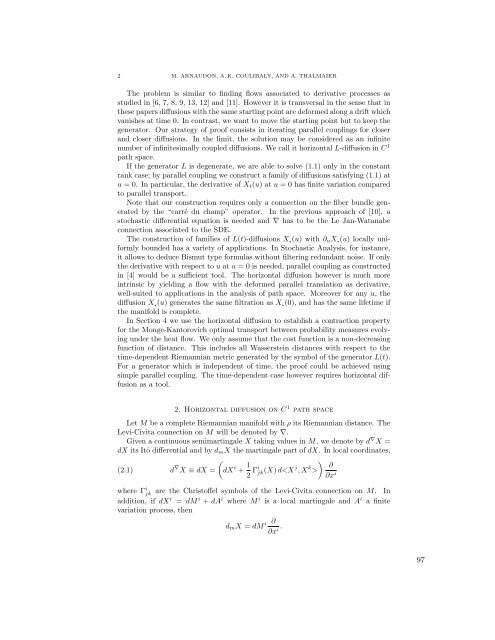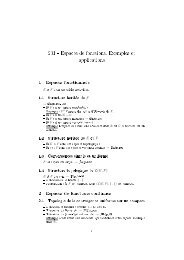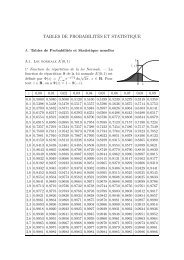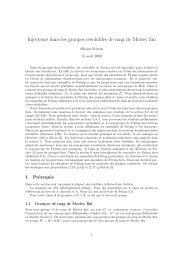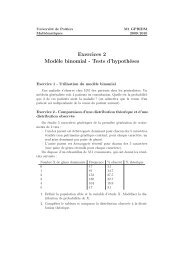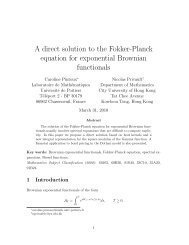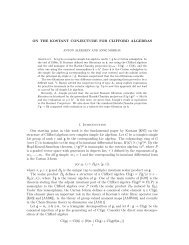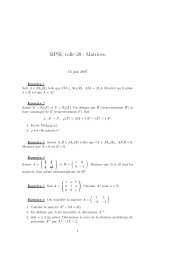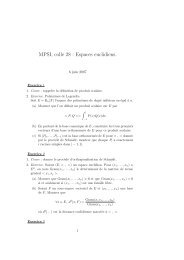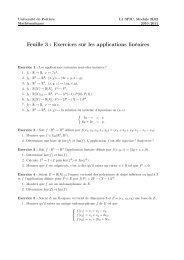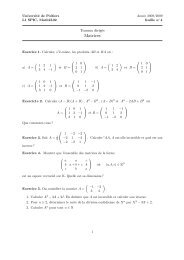THÃSE Koléhè Abdoulaye COULIBALY-PASQUIER
THÃSE Koléhè Abdoulaye COULIBALY-PASQUIER
THÃSE Koléhè Abdoulaye COULIBALY-PASQUIER
- No tags were found...
You also want an ePaper? Increase the reach of your titles
YUMPU automatically turns print PDFs into web optimized ePapers that Google loves.
2 M. ARNAUDON, A. K. <strong>COULIBALY</strong>, AND A. THALMAIERThe problem is similar to finding flows associated to derivative processes asstudied in [6, 7, 8, 9, 13, 12] and [11]. However it is transversal in the sense that inthese papers diffusions with the same starting point are deformed along a drift whichvanishes at time 0. In contrast, we want to move the starting point but to keep thegenerator. Our strategy of proof consists in iterating parallel couplings for closerand closer diffusions. In the limit, the solution may be considered as an infinitenumber of infinitesimally coupled diffusions. We call it horizontal L-diffusion in C 1path space.If the generator L is degenerate, we are able to solve (1.1) only in the constantrank case; by parallel coupling we construct a family of diffusions satisfying (1.1) atu = 0. In particular, the derivative of X t (u) at u = 0 has finite variation comparedto parallel transport.Note that our construction requires only a connection on the fiber bundle generatedby the “carré du champ” operator. In the previous approach of [10], astochastic differential equation is needed and ∇ has to be the Le Jan-Watanabeconnection associated to the SDE.The construction of families of L(t)-diffusions X.(u) with ∂ u X.(u) locally uniformlybounded has a variety of applications. In Stochastic Analysis, for instance,it allows to deduce Bismut type formulas without filtering redundant noise. If onlythe derivative with respect to u at u = 0 is needed, parallel coupling as constructedin [4] would be a sufficient tool. The horizontal diffusion however is much moreintrinsic by yielding a flow with the deformed parallel translation as derivative,well-suited to applications in the analysis of path space. Moreover for any u, thediffusion X.(u) generates the same filtration as X.(0), and has the same lifetime ifthe manifold is complete.In Section 4 we use the horizontal diffusion to establish a contraction propertyfor the Monge-Kantorovich optimal transport between probability measures evolvingunder the heat flow. We only assume that the cost function is a non-decreasingfunction of distance. This includes all Wasserstein distances with respect to thetime-dependent Riemannian metric generated by the symbol of the generator L(t).For a generator which is independent of time, the proof could be achieved usingsimple parallel coupling. The time-dependent case however requires horizontal diffusionas a tool.2. Horizontal diffusion on C 1 path spaceLet M be a complete Riemannian manifold with ρ its Riemannian distance. TheLevi-Civita connection on M will be denoted by ∇.Given a continuous semimartingale X taking values in M, we denote by d ∇ X =dX its Itô differential and by d m X the martingale part of dX. In local coordinates,((2.1) d ∇ X ≡ dX = dX i + 1 ) ∂2 Γi jk(X) d∂x iwhere Γ i jkare the Christoffel symbols of the Levi-Civita connection on M. Inaddition, if dX i = dM i + dA i where M i is a local martingale and A i a finitevariation process, thend m X = dM i ∂∂x i . 97


